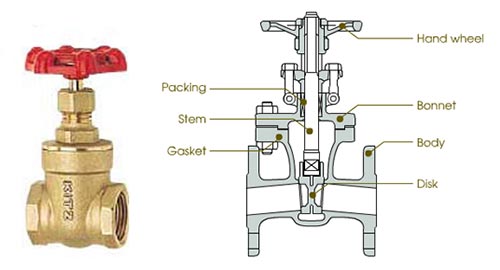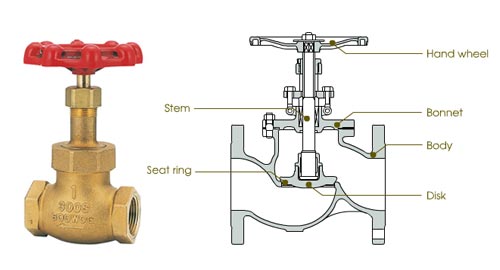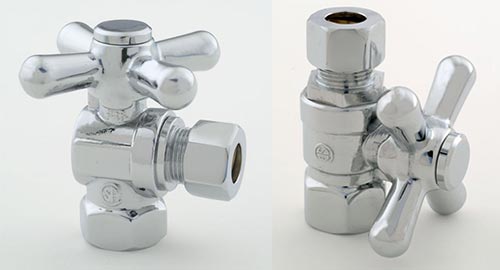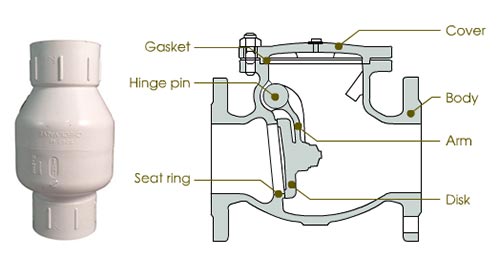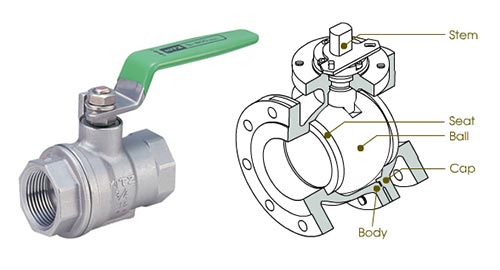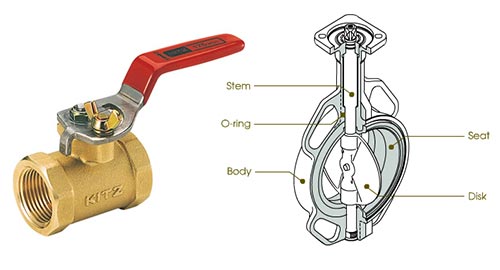Plumbing is all about controlling water (and gas, and other things). When you want to control water, you need valves. There's a lot that goes into manufacturing and selecting the right valve for the occasion, so that when it comes time (e.g. the toilet is on the cusp of overflowing), all you need to do is bend down and give a turn to the handle without another thought: crisis averted! (unless you don't have a plunger...)
There are a number of ways in which valves are used in plumbing, and selecting the right valve requires research on the particular application, and/or the assistance of a manufacturer or professional. The information provided here is meant to be only a general overview of the chief types used: what they do, and how they work.
Gate Valves
Gate valves are an oldie, but still a goodie. Chiefly used for commercial, industrial, and institutional applications these days, gate valves feature... well, a "gate" (also referred to as a wedge, or disc) that when lowered, seals off the flow. When raised, it's retracted into the body of the valve, which means no loss of flow; the inside diameter of the valve matches that of the pipe it's connected to. This is all controlled by a wheel handle, and can be of the "Open Stem and Yoke", or the "Non-Rising" varieties: with an open stem and yoke, the handle moves down the stem with the gate; non-rising stems remain fixed. The clear benefit of the open stem and yoke is that you're given an indicator of the valve's status: if the handle is down, you know it's closed. However, depending on the size of the valve, there may not be enough space for its operation: enter the non-rising gate valve.
Purchase Brass Gate Valves Here
Quick Tip: Gate valves are intended for fully opened/closed applications, and are not recommended for "throttling", or adjusting flow, since the movement of water against only part of the gate could lead to damage. Keep in mind that gate valves can seize or become stuck after long periods of being only opened or closed.
Globe Valves
Next, we have the globe valve. This type operates using a stopper, which is lowered onto a baffle, blocking flow. Because of the space the baffle takes up inside the valve, flow is restricted, making these exactly the wrong type of valve to use in a full-flow situation. They are, however, good for throttling and are not bothered by frequent operation.
Because of their design, gate valves and globe valves close relatively slowly, and can be used in situations where water hammer is a concern.
Purchase Brass Globe Valves Here
Stop Valves (Angled & Straight)
Though any valve can act as a stop (blocking flow from the supply), some valves are designed primarily for this purpose. You'll see them behind your toilet, under your sink, and at the supplies of other fixtures. They provide an easy and convenient shut-off mechanism for those supplies, that often come out from a wall and travel up or down to reach them, hence the angle. Sometimes, things just line up, in which case, all that's needed is a straight stop. Internally, these valves can use any of the primary internal mechanisms: ball, globe, gate. However they operate, they're preferred over the alternative (using a standard globe valve plus elbow), since their designs result in less flow restriction.
Most angle or straight stops come in a compression or 1/4-turn style. A 1/4-turn valve is simply one that is activated with a quarter turn of the handle, rather than one or several full rotations like a compression valve. Usually ball valves, these are not designed for throttling, just quick, convenient shut-off for fixtures like toilets and sinks.
Purchase Angle & Straight Stop Valves Here
Check Valves
The water moving through your plumbing should only travel one way: from the supply lines and out through a fixture, or from a drain to the sewer main. To assure a one-way flow in the event of a "cross-connection" (wastewater flowing back into the supply), a check valve is necessary (backflow prevention). Some use a ball that's forced into a hole when flow is reversed, blocking the outlet. Swing checks use a flapper that's forced into position by water flowing the wrong direction. Others use diaphragms or spring-mounted discs. These types of check valves are called "non-operational", in that they do not require anyone to activate them: it's all physics, and all automatic. For an operational check valve, look for a stop-check: these still work automatically, but allow you to manually stop flow in either or both directions. Check valves can also be integrated with other features in something like a Reduced Pressure Zone Assembly (a backflow prevention device).
Purchase PVC Check Valves Here
Quick Tip: Silent/spring-loaded check valves are available, featuring a spring mechanism that allows the valve to close quickly, even before the rush of backflow hits. These can greatly reduce the potential for water hammer.
Ball Valves
Probably the most widely-used valve design, ball valves employ a cored, rotating ball to control flow. Usually operated by lever handle, they also offer a quick view of their status. Their design makes them ideal for full-flow applications, and their easy, low-wear operation is also excellent for throttling. A quality ball valve can be opened and closed a hundred times a day with little impact on the valve mechanism itself, so you can expect to get a long life out of these valves with very little maintenance or trouble. They come in a very wide range of materials and styles, including brass, stainless steel, PVC, threaded, and push-to-fit, to suit almost any application.
Quick Tip: When you need a metal valve and have the option, go for a forged metal body. These manufacturing processes produce a stronger, higher-quality piece than casting or fabrication.
Butterfly Valves
Butterfly valves are not particularly beautiful (it's pretty disappointing, we know). In fact, they look a lot like any other valve. The butterfly moniker refers instead to the mechanism inside, essentially a disc that rotates by handle turns; this of course means that flow is reduced through the valve. Although these valves can be used for throttling – some include locking mechanisms on the handle to counteract the force of water on the disc – they are best utilized fully opened or closed. Among the valve types, butterfly valves are compact, with relatively short bodies, making them significantly lighter than other types. Keep in mind, however, that these valves rely on a gasket which will eventually need replacement.
While some of the backflow preventers we offer utilize a butterfly mechanism, we typically recommend a ball valve for situations where you're considering a butterfly valve.
Valves are manufactured using a wide variety of materials, from bronze to PVC plastic. Certain materials perform well in certain circumstances, but fail miserably in others. You'll need to pay attention to your medium (water? effluent?), the pressure and temperatures the valve will be subjected to, and the nature of the application itself: are you trying to regulate flow, stop it in an emergency, or just have a convenient shut-off mechanism? That information, along with the basics found here, will light the way to the valve you need, and the peace of mind you deserve!



 English
English 中文简体
中文简体